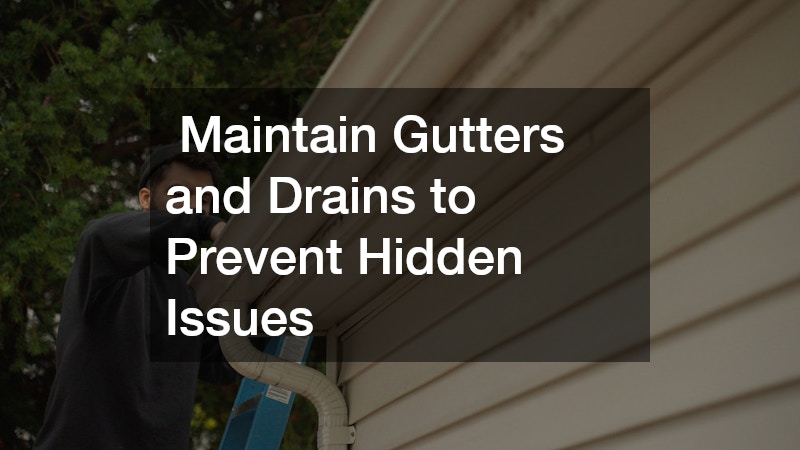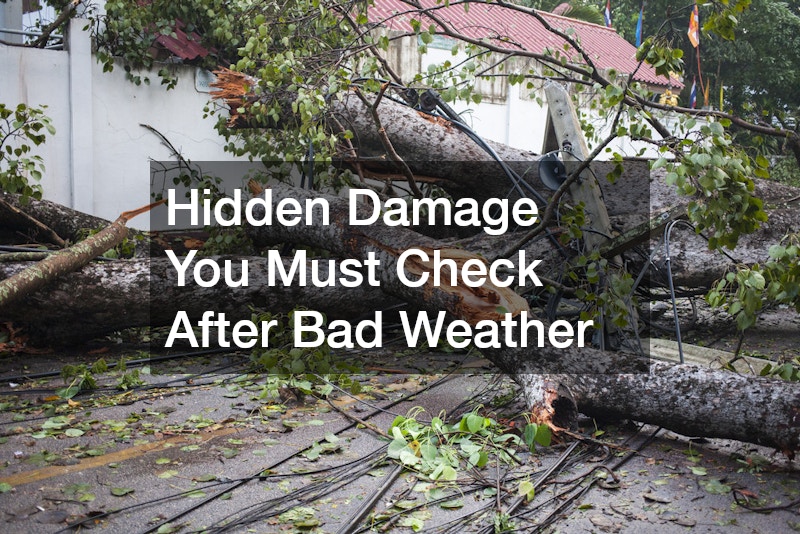Severe weather can leave your home looking deceptively fine on the surface. A storm may pass, leaving only scattered leaves, minor debris, or wet patches in your yard, but hidden damage could be lurking—damage that is often invisible until it becomes a costly problem. From small leaks inside walls to weakened trees threatening your property, these issues can compromise safety, lead to expensive repairs, and even pose health risks if left untreated.
Understanding what to inspect, and when to call in professional help, is key to protecting your home. This guide takes a thorough, actionable approach to uncover hidden storm damage, offering specific steps for every area of your property.
1. Inspect Your Roof for Hidden Vulnerabilities
Your roof serves as the first and most critical line of defense against storms, hail, heavy rainfall, and other severe weather events. While large, visible damage like missing shingles or holes is easy to spot, many issues develop gradually and remain hidden until they cause significant problems. Subtle damage such as small cracks, lifted or curling shingles, or compromised flashing can allow water to infiltrate the roof structure, leading to leaks, mold growth, and long-term structural decay. Regular, thorough inspections are essential to identify problems early and prevent costly repairs.
Steps for thorough roof inspection:
-
Visual check from the ground: Use binoculars to look for loose, missing, or curled shingles. Even a few missing shingles can let water penetrate and damage the underlayment.
-
Check for granule loss: Asphalt shingles lose granules over time. Piles of granules in gutters indicate wear that compromises water resistance.
-
Inspect flashing and vents: Damaged flashing around chimneys, skylights, or vents is a common source of leaks. Bent or missing flashing is a red flag.
-
Examine the attic: Look for water stains, mold, or sunlight peeking through the roof. These can indicate small leaks that may not be visible from the outside.
Why professional help matters:
A roof repair service can spot subtle issues that homeowners often miss, such as roof deck damage, deteriorated underlayment, or hidden leaks. They can make preventive repairs before small problems escalate into expensive emergencies.
Preventive tips:
-
Trim overhanging branches to prevent impact damage during storms.
-
Schedule annual inspections, especially before rainy or snowy seasons.
-
Keep gutters clean to ensure water flows off the roof properly.
Regular, proactive roof maintenance minimizes hidden damage, protects the structural integrity of your home, and extends the lifespan of the roof. By combining visual inspections, professional evaluations, and preventive measures, homeowners can detect early signs of trouble, prevent leaks and mold, and avoid costly repairs down the line. A well-maintained roof not only protects the interior of your home but also ensures long-term durability against the elements.
2. Check for Hidden Leaks in Plumbing and Walls

Storms often exacerbate pre-existing leaks or create new ones that remain hidden behind walls, under floors, or within ceilings. These leaks can be deceptively small but cause significant damage over time. Even minor water intrusion can silently erode structural elements, foster mold growth, and increase water bills, making early detection critical.
Signs to watch for:
-
Discoloration or bubbling paint: Water trapped behind drywall can create yellow or brown stains and cause the paint to peel or bubble.
-
Soft spots on floors or ceilings: Press gently on suspect areas; soft or spongy surfaces often indicate moisture absorption.
-
Musty odors: Persistent musty smells, particularly in closed spaces like basements or attics, often signal hidden water problems.
-
Unexplained high water bills: Even minor leaks can lead to a noticeable increase in consumption.
Professional intervention:
A leak detection service uses specialized equipment, such as moisture meters, thermal imaging, and pipe cameras, to locate leaks that are invisible to the naked eye. They can detect hidden leaks in walls, ceilings, and underground pipes without unnecessary demolition.
Temporary DIY solutions:
-
Shut off the water supply to affected areas to prevent further damage.
-
Place buckets or towels under leaks to contain water.
-
Use temporary sealants or plumber’s tape for minor visible cracks until a professional can inspect.
Early detection prevents structural deterioration, mold growth, and escalating repair costs, making leak inspections critical after any major storm.
3. Address Water Damage Before It Becomes Mold
Water damage is one of the most serious and insidious problems that can follow a storm. Even small amounts of water that penetrate walls, floors, or basements can compromise the structural integrity of your home and create an environment conducive to mold, mildew, and decay. Ignoring these issues can lead to long-term consequences, including wood rot, electrical hazards, and health risks for occupants. Thorough inspection, immediate mitigation, and professional assistance are essential to prevent hidden damage from worsening.
Key areas to inspect for water damage:
-
Basements and crawl spaces: Check for puddles, wet carpets, or damp insulation. These areas are prone to flooding and water retention.
-
Behind walls: Discolored paint or wallpaper and peeling surfaces often indicate trapped moisture.
-
Around windows and doors: Storms can compromise seals, allowing water to leak in and damage framing and trim.
Professional help:
A water damage restoration company specializes in rapid water removal, structural drying, dehumidification, and repairs. They ensure that all hidden moisture is addressed, reducing the risk of mold development and structural damage.
DIY mitigation tips:
-
Remove standing water immediately using mops, towels, or wet vacuums.
-
Set up fans and dehumidifiers to accelerate drying.
-
Remove wet carpeting or furniture to prevent staining and warping.
-
Inspect insulation and replace any wet materials to prevent mold growth.
Prompt attention to water intrusion is critical to protecting both the safety and long-term value of your home. Even minor water exposure can escalate into serious structural, electrical, and health hazards if left untreated. By conducting thorough inspections, removing standing water, drying materials effectively, and engaging professional water damage restoration services when necessary, homeowners can safeguard their property and prevent hidden storm-related damage from becoming a costly, long-term problem.
4. Maintain Gutters and Drains to Prevent Hidden Issues

Clogged gutters and poorly maintained drainage systems are one of the most common causes of hidden damage after storms. When water is unable to flow freely away from your home, it can pool around foundations, seep into walls, erode landscaping, and create conditions for mold, mildew, and structural decay. Even minor blockages or damaged gutters can lead to significant problems over time, making thorough inspection and maintenance essential.
Inspection checklist:
-
Remove leaves, branches, and debris from gutters and downspouts.
-
Check gutters for cracks, rust, or loose attachments.
-
Ensure downspouts direct water at least five feet away from your foundation.
-
Inspect yard drainage for low spots where water collects.
Professional services:
-
Drain cleaning service: Professional drain cleaning ensures that underground or surface drains remain free-flowing and clear of sediment, mud, and debris. Storm runoff often carries natural debris that can block drains, causing slow drainage, standing water, or localized flooding. Experts use tools such as high-pressure water jets, mechanical snakes, and inspection cameras to identify and remove blockages efficiently, preventing hidden damage to foundations, walkways, and soil.
-
Gutter repair professionals: Skilled professionals can repair leaks caused by cracks, rust, or joint separation, realign sagging sections to ensure proper water flow, and replace damaged or missing gutter segments. Properly functioning gutters channel water safely away from your home, protecting the foundation, preventing basement flooding, and minimizing soil erosion around landscaping. Addressing these issues promptly prevents silent, long-term damage.
DIY maintenance tips:
-
Use gloves and safety goggles when cleaning gutters.
-
Test water flow with a hose to ensure downspouts are functioning correctly.
-
Schedule seasonal maintenance before and after storm seasons.
Proper gutter and drainage maintenance is crucial for preventing hidden water damage to foundations, walls, and landscaping. By ensuring water is safely diverted away from your home, you protect structural integrity, prevent mold growth, and minimize erosion around your property. Regular inspections, preventive maintenance, and timely professional assistance create a reliable defense against storm-related hidden damage, ultimately saving homeowners from costly repairs and long-term problems.
5. Examine Windows and Doors for Weather Damage
Windows and doors are critical barriers against the elements, yet they are often overlooked during post-storm inspections. Even minor gaps, cracks, or misalignments can allow water, air, and pests to enter your home. Over time, this hidden intrusion can lead to structural damage, energy loss, and increased risk of mold growth. Regular inspection after storms is essential to ensure that your windows and doors maintain a tight seal and continue to protect your home.
Inspection tips:
-
Look for condensation between double-pane glass.
-
Check for drafts along frames using your hand or a candle.
-
Inspect caulking and weatherstripping for cracks or gaps.
-
Ensure frames are straight and not warped from pressure or water infiltration.
Professional help:
For serious damage or water leaks, a window replacement professional can replace compromised windows and ensure proper sealing.
DIY tips for minor issues:
-
Apply weatherstripping to reduce drafts and prevent water infiltration.
-
Use temporary caulking or sealant for small cracks.
-
Keep interior surfaces dry to avoid water damage from leaks.
Maintaining tight seals around windows and doors is crucial for long-term protection. Proper inspection, combined with prompt repairs or preventive measures, helps preserve structural integrity, prevents hidden water damage, and keeps your home comfortable and energy-efficient.
6. Inspect Electrical Systems for Hidden Hazards

Storms can severely compromise electrical systems, especially when water infiltrates wiring, outlets, circuit breakers, or the main electrical panel. Hidden electrical damage is particularly dangerous because it may not be immediately visible, yet it can lead to fires, electrocution, and damage to appliances or electronics. Even minor water exposure to electrical components can create hazards that worsen over time, making post-storm inspection essential.
Signs of hidden electrical damage:
-
Flickering or dimming lights during or after a storm.
-
Frequently tripped breakers or blown fuses.
-
Burnt smells or scorch marks around outlets.
-
Corroded exterior outlets exposed to water or moisture.
Professional help:
A local electrician can inspect the entire electrical system, including wiring, outlets, and circuit breakers, to identify water damage or short circuits.
Safety tips for homeowners:
-
Shut off power to areas affected by flooding or water intrusion.
-
Avoid touching electrical devices in wet areas.
-
Never attempt major electrical repairs unless certified.
Prompt electrical inspections after storms protect your home and family from potentially fatal hazards. Early detection prevents fires, reduces the risk of electrocution, and safeguards expensive electronics and appliances from short circuits or surges. By combining careful observation of warning signs with professional intervention, homeowners can ensure their electrical system remains safe and functional even after severe weather events.
7. Look for Mold Growth in Concealed Areas
Mold is one of the most common and insidious consequences of storm-related water intrusion. It thrives in damp, hidden locations such as behind walls, under floors, inside attics, and around plumbing or HVAC systems. Even small leaks or residual moisture after a storm can create the perfect environment for mold growth, which can spread rapidly if left untreated. Beyond damaging building materials, mold poses serious health risks, including respiratory problems, allergic reactions, and infections—making early detection and remediation essential.
Signs of hidden mold:
-
Musty or earthy odors, even in dry areas.
-
Discoloration or fuzzy spots on walls, ceilings, or floors.
-
Allergy symptoms such as sneezing, coughing, or watery eyes.
Professional help:
Certified mold inspectors can detect mold in concealed areas using moisture meters, infrared cameras, and air quality testing. They can identify hidden colonies that could otherwise remain untreated.
Preventive tips:
-
Keep crawl spaces, basements, and attics ventilated.
-
Use dehumidifiers in damp areas.
-
Fix leaks promptly to prevent mold from gaining a foothold.
Mold can spread quickly through hidden cavities, insulation, and wooden structures, leading to expensive repairs and health problems if ignored. Early detection and removal prevent structural deterioration, reduce the risk of respiratory issues, and protect the long-term value of your home. By combining careful observation with professional inspection and preventive measures, homeowners can minimize mold hazards and maintain a safer, healthier living environment after storms.
8. Assess Trees and Landscaping Damage
Storms often leave behind more than just visible debris—they can cause hidden damage to trees and landscaping that poses serious risks to property and safety. Even if a tree looks intact, internal cracks, weakened roots, or hidden decay may make it prone to falling or shedding large branches. These hazards can cause structural damage to your home, vehicles, fences, or even injure people and pets if left unchecked.
Inspection tips:
-
Check for broken, split, or hanging branches.
-
Look for leaning trees or roots that appear exposed or unstable.
-
Assess whether previously healthy trees now show signs of internal decay.
Professional help:
A tree removal company can safely prune or remove hazardous trees, particularly those near your home, power lines, or walkways.
DIY tips for minor damage:
-
Remove small fallen branches and clear debris from yards and gutters.
-
Avoid attempting major tree removal without proper training or equipment.
-
Regularly inspect trees after storms to prevent gradual damage from worsening.
Maintaining trees and landscaping after a storm is more than aesthetic—it’s essential for safety. Prompt inspections, minor cleanup, and professional intervention when necessary reduce the risk of hidden hazards, prevent property damage, and keep your outdoor environment safe and stable.
9. Deep Clean Your Home to Prevent Long-Term Damage
Debris, mud, and water residue left behind after storms can cause hidden damage to floors, walls, and surfaces that may not be immediately visible. Even after water recedes, lingering moisture and sediment can seep into porous materials, warp wood, stain carpets, promote rust on metal surfaces, and create ideal conditions for mold and mildew. Thorough post-storm cleaning is crucial not only to restore the appearance of your home but also to prevent long-term structural and health problems.
Areas to focus on:
-
Floors: Remove water residues and dry carpets, tiles, and hardwood floors thoroughly.
-
Surfaces: Wipe away mud, dirt, and sediment from furniture and counters.
-
Furniture and upholstery: Dry and disinfect damp items to prevent permanent staining or mold.
Professional help:
A cleaning service can handle thorough post-storm cleanup, particularly for homes that experienced flooding, mud, or extensive debris.
DIY tips:
-
Use fans and dehumidifiers to accelerate drying.
-
Remove waterlogged items promptly.
-
Disinfect areas that were exposed to floodwater or standing water.
Maintaining cleanliness after a storm is about more than aesthetics—it protects structural elements, preserves furniture and flooring, and creates a healthier indoor environment. By addressing residual water, mud, and debris quickly and systematically, homeowners can prevent hidden damage from evolving into costly repairs or health hazards like mold, mildew, and bacterial contamination.
Conclusion
After bad weather, the visible damage is often just the tip of the iceberg. Hidden problems—ranging from roof leaks and water intrusion to electrical hazards, mold, and weakened trees—can compromise your home, create health risks, and result in costly repairs.
A systematic inspection combined with professional help is essential. By checking roofs, plumbing, gutters, windows, electrical systems, mold-prone areas, trees, and performing deep cleaning, you can uncover and address hidden damage early. This proactive approach not only protects your home but also ensures the safety and well-being of everyone living there.
Storms may be unpredictable, but your response to them doesn’t have to be. With careful attention and timely action, you can safeguard your property and prevent hidden damage from turning into serious problems.
